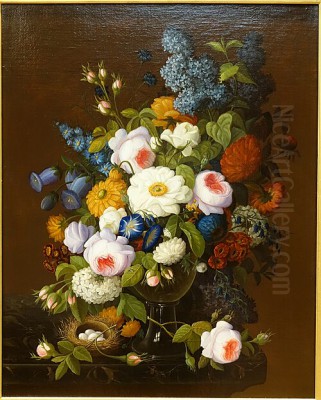
Severin Roesen stands as a pivotal figure in the history of American still life painting during the mid-nineteenth century. Though born and likely trained in Germany, his most prolific and defining years were spent in the United States, where his lush, detailed canvases captured the optimistic spirit and material aspirations of a growing nation. His work, deeply rooted in the traditions of Dutch Golden Age masters, found fertile ground in America, particularly in the burgeoning communities of Pennsylvania. Roesen's paintings, overflowing with meticulously rendered fruits and flowers, became synonymous with Victorian ideals of plenty and natural beauty, leaving a legacy that continues to fascinate art historians and collectors alike.
European Origins and Artistic Formation
Severin Roesen was born around 1815 near Cologne, Germany. Details about his early life and formal artistic training remain scarce, a common challenge when researching artists of this period, particularly immigrants whose records may be incomplete. However, it is known that he worked as a porcelain painter in Cologne before transitioning to canvas. This background in decorative arts likely honed his meticulous attention to detail and his skill in rendering precise forms and vibrant colors, qualities that would become hallmarks of his later oil paintings.
The artistic environment of the Rhineland during Roesen's formative years was influenced by the Biedermeier style, which emphasized domesticity and realism, as well as a continued appreciation for the Netherlandish masters of the 17th century. It is highly probable that Roesen studied the works of artists like Jan van Huysum, Rachel Ruysch, and Jan Davidsz. de Heem, whose opulent floral and fruit compositions clearly resonate in Roesen's own oeuvre. He may also have been aware of contemporary German still life painters like Johann Wilhelm Preyer, who worked in a similarly detailed style. Roesen exhibited a painting in Cologne in 1847 before making the life-altering decision to emigrate.
Emigration and the New York Years
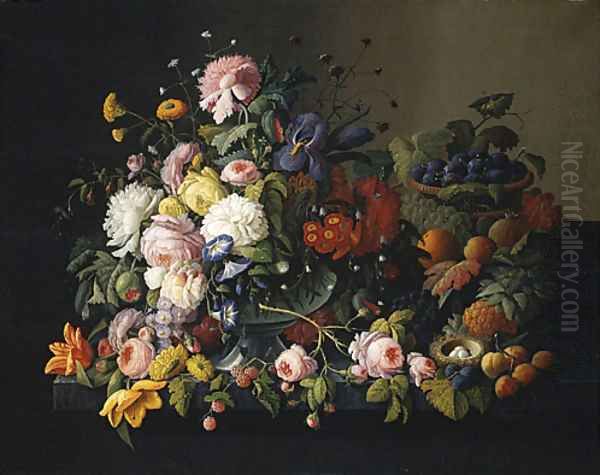
In 1848, a year marked by widespread political revolutions and social unrest across Europe, Severin Roesen emigrated to the United States, arriving in New York City. The exact reasons for his departure from Germany are not definitively documented, but the turbulent political climate is often cited as a likely factor. He may have traveled with his wife, Sophia Jacobina Lambricht, and potentially children, although records are unclear. Sadly, Sophia is believed to have died shortly after their arrival or perhaps even during the journey.
New York City, a bustling hub of commerce and culture, offered Roesen opportunities to establish himself. He began exhibiting his work almost immediately, showcasing his still lifes at the American Art-Union between 1848 and 1852. The American Art-Union was a significant institution in the mid-19th century American art world, operating on a subscription model that distributed paintings by lottery to its members across the country. This exposure helped Roesen gain recognition and patrons beyond the confines of the city. During this period, he remarried Wilhelmine Ludwig, and together they would have several children. His paintings from the New York era already displayed the complexity and abundance that would characterize his mature style.
The Williamsport Period: A Flourishing Career
Around 1857 or 1858, Roesen made a significant move, relocating his family from the metropolitan center of New York to the relatively smaller, but rapidly growing, town of Williamsport in Lycoming County, Pennsylvania. Williamsport was booming, fueled by the lucrative lumber industry that earned it the nickname "Lumber Capital of the World." This industry created immense wealth for a new class of entrepreneurs and merchants – the "lumber barons" – who were eager to display their success through fine homes and sophisticated furnishings, including art.
Roesen found an appreciative audience in Williamsport. His elaborate still lifes, depicting tables laden with a profusion of fruits and flowers, perfectly mirrored the sense of prosperity and optimism prevalent among the town's elite. He became a well-known figure in the community, often trading paintings for goods or lodging, and teaching art to local residents. Many of his most ambitious and large-scale works were produced during his time in Williamsport, which lasted until about 1872. The patronage he received there allowed him to flourish creatively, producing hundreds of canvases that celebrated nature's bounty.
Artistic Style: Detail, Color, and Composition
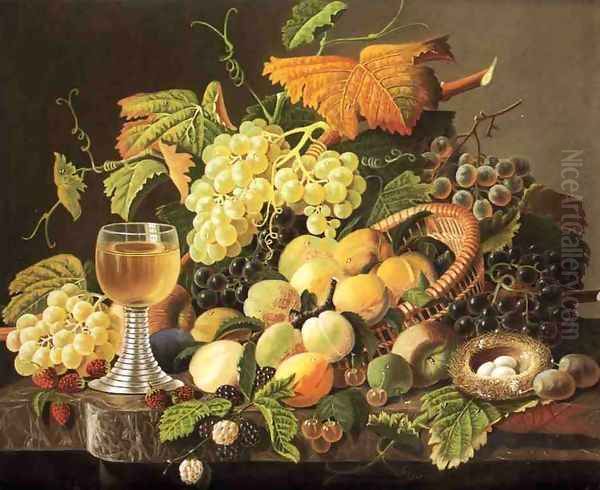
Severin Roesen's style is immediately recognizable for its astonishing level of detail, vibrant color palette, and complex, often overflowing compositions. He worked firmly within the tradition of realism, aiming for a high degree of verisimilitude in his depictions of natural objects. Each grape, berry, petal, and leaf is rendered with painstaking care, often including minute details like dewdrops, tiny insects, or the subtle textures of fruit skins and flower petals. This meticulousness invites close inspection, rewarding the viewer with a sense of wonder at the diversity and perfection of nature.
His use of color was equally distinctive. Roesen employed rich, saturated hues, creating a sense of vibrancy and lushness. Reds, purples, greens, and yellows dominate his fruit arrangements, while his floral pieces showcase a dazzling array of pinks, whites, blues, and crimsons. He skillfully used light and shadow (chiaroscuro) to model forms, giving his subjects a three-dimensional presence and enhancing the overall richness of the scene. The interplay of light on reflective surfaces like glass, water droplets, or polished fruit skin adds another layer of visual complexity and realism.
Compositionally, Roesen favored abundance. His still lifes are typically characterized by a dense arrangement of objects, often piled high in a pyramidal structure or spilling generously out of baskets or across marble tabletops. While seemingly chaotic, these compositions are carefully orchestrated, balancing shapes, colors, and textures to create a harmonious, if opulent, whole. He frequently employed a slightly elevated viewpoint, allowing the viewer to look down upon the arrangement, further emphasizing the sense of profusion. Common settings include simple wooden tables or, more frequently, cool marble ledges, which provide a neutral, stable contrast to the organic richness above.
Recurring Motifs and Symbolism
Roesen's paintings feature a consistent repertoire of motifs. Fruits are perhaps his most common subject, with grapes (especially translucent green and deep purple varieties), strawberries, peaches, plums, apples, pears, and melons appearing frequently. He often depicted fruit sliced open, revealing juicy interiors and seeds, adding to the sense of immediacy and sensory appeal. Flowers, sometimes presented alone but often combined with fruit, included roses, tulips, lilies, morning glories, and fuchsias, among others.
Beyond the primary subjects, Roesen often incorporated secondary elements that add interest and context. A recurring feature is a bird's nest, typically small and delicately rendered, sometimes containing eggs. This motif, common in Dutch still life, can symbolize domesticity, fertility, or the fragility of life. Wine glasses, sometimes filled with wine or champagne, appear in many compositions, suggesting celebration and conviviality, and adding a touch of human presence and luxury. Overturned baskets, spilling their contents, contribute to the feeling of overwhelming abundance.
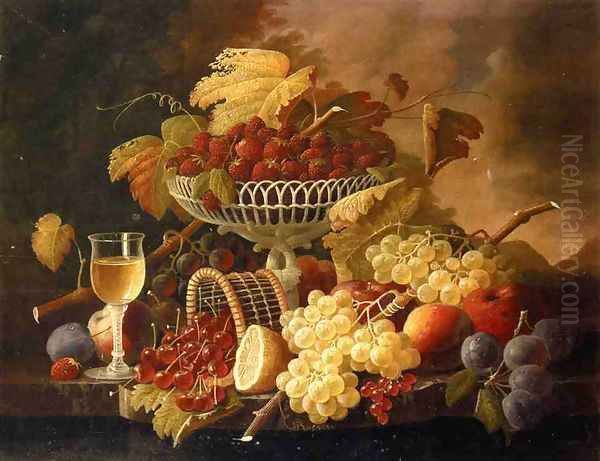
While Roesen's primary aim seems to have been the celebration of visual beauty and material plenty, his works can also be viewed through the lens of traditional symbolism inherited from Dutch art. Flowers might suggest the transience of beauty (vanitas), while abundant fruit could symbolize fertility, divine blessing, or even the temptations of earthly pleasure. However, in the context of mid-19th century America, the dominant interpretation likely focused on the more straightforward celebration of nature's bounty and the prosperity enjoyed by the nation and its successful citizens. His paintings served as affirmations of the American dream, visualized as a table overflowing with nature's gifts.
Signature Elements and Technique
While not all of Roesen's works are signed or dated, he did employ several methods of identification. His most common signature is "S. Roesen," often rendered in fine script, sometimes incorporating the date. Art historians have also noted his occasional, more subtle signature integrated into the painting itself, such as forming his initials or name from a delicate grapevine tendril snaking among the fruit. This playful approach adds another layer of discovery for the keen observer.
His technique involved careful layering of oil paints, often using glazes to achieve depth and luminosity, particularly in the rendering of fruits like grapes. His brushwork is generally very fine and controlled, leaving little visible texture, which enhances the illusion of reality. He likely worked from direct observation of fruits and flowers, but also probably relied on sketches, memory, and established compositional formulas, given the repetition of certain elements and arrangements across multiple paintings. The sheer volume of his output suggests a disciplined and efficient working method.
Representative Works
Among Roesen's extensive body of work, several paintings stand out as exemplary of his style and are held in major collections.
Still Life: Flowers and Fruits (c. 1848, Metropolitan Museum of Art): An early American work, likely painted shortly after his arrival in New York. It showcases his already developed skill, featuring a rich assortment of flowers like roses and tulips alongside peaches, grapes, and berries, arranged on a marble ledge. It clearly demonstrates the Dutch influence and sets the stage for his later, even more elaborate compositions.
Fruit Still Life with Bird's Nest (c. 1850s, White House Collection): This painting, famously acquired by Jacqueline Kennedy for the White House, exemplifies Roesen's mature style. It features a characteristic abundance of fruit—grapes, peaches, strawberries, plums—piled high and spilling from a wicker basket onto a marble surface, with a delicate bird's nest tucked among the bounty. Its acquisition significantly boosted Roesen's posthumous reputation.
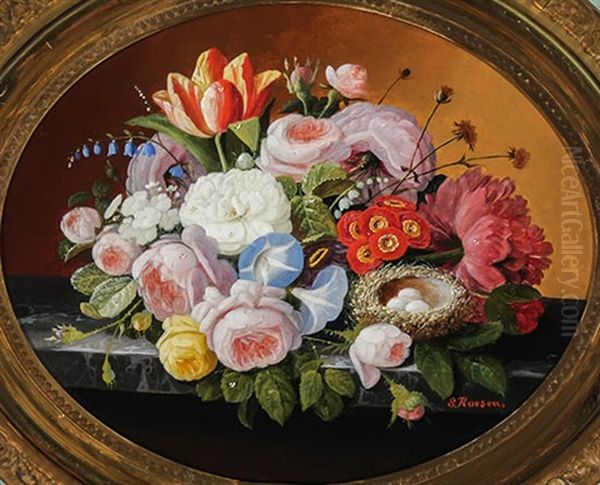
Still Life with Fruit (c. 1860s, National Gallery of Art, Washington D.C.): A large and complex composition typical of his Williamsport period. It presents an almost overwhelming profusion of various fruits, meticulously detailed and vibrantly colored, demonstrating his mastery of texture and light. The sheer variety and quantity of fruit depicted speak to the themes of abundance and natural wealth.
Flower Still Life with Bird's Nest (c. 1860-1870, Museum of Fine Arts, Boston): While renowned for fruit, Roesen also created stunning floral pieces. This work features a lush bouquet of diverse flowers in a vase, again accompanied by the signature bird's nest, showcasing his ability to capture the delicate textures and forms of petals and leaves with the same precision he applied to fruit.
These examples, among hundreds of others, illustrate Roesen's consistent dedication to the still life genre and his remarkable ability to infuse traditional formats with a sense of vibrant energy and meticulous detail that appealed strongly to his American audience.
Influence and Contemporaries
Severin Roesen worked during a period when still life painting was experiencing a resurgence in popularity in America. He was part of a broader movement, yet his specific style, heavily indebted to the Dutch Baroque, set him apart from some of his American contemporaries.
His most significant artistic lineage traces back to the 17th-century Dutch masters like Jan Davidsz. de Heem, Willem Kalf, Rachel Ruysch, and Jan van Huysum. Their emphasis on realism, complex compositions, rich symbolism, and technical virtuosity provided a clear model for Roesen. He adapted this tradition for an American audience that increasingly valued demonstrations of prosperity and appreciated detailed craftsmanship.
In the American context, Roesen followed in the footsteps of the Peale family – Charles Willson Peale, Raphaelle Peale, James Peale, and Sarah Miriam Peale – who were pioneers of still life painting in the early republic. However, Roesen's style was generally more opulent and less restrained than the often austere arrangements of Raphaelle Peale.
Among his direct contemporaries specializing in fruit and flower painting was John F. Francis, whose work sometimes approached Roesen's level of abundance but often retained a slightly simpler, more planar composition. George Henry Hall also painted fruit still lifes, sometimes with a more focused, less cluttered approach. While different in subject matter, Martin Johnson Heade, known for his landscapes and paintings of orchids and hummingbirds, shared Roesen's fascination with the detailed rendering of natural forms.
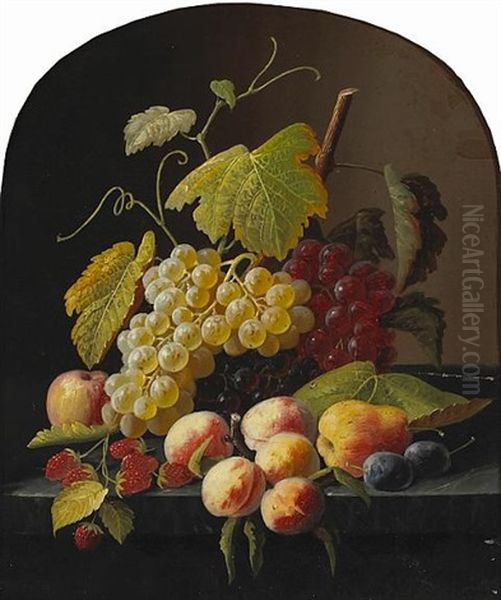
Roesen's influence can be seen in the work of painters who followed him, particularly those active in central Pennsylvania. Paul Lacroix, another immigrant artist, clearly borrowed compositional structures and motifs from Roesen. Later American still life painters, including the trompe-l'oeil masters like William Michael Harnett, John Haberle, and John Frederick Peto, took American realism in a different direction, focusing on man-made objects and illusionistic deception, but Roesen's work represents a high point in the tradition of natural abundance painting in 19th-century America. His success demonstrated the viability and appeal of highly finished, European-influenced still life in the American market.
Personal Life and Mysterious Disappearance
While Roesen achieved considerable professional success, details about his personal life remain somewhat fragmented. After the death of his first wife, Sophia, he married Wilhelmine Ludwig around 1854. They had at least three children: daughters Minnie and Emma, and a son, Oscar. Family life seems to have involved moves between New York and Pennsylvania, possibly reflecting Roesen's pursuit of commissions and exhibition opportunities. Census records place him in Williamsport through the 1860s and into the early 1870s.
His personality is described in local Williamsport accounts as somewhat eccentric, fitting the archetype of the artistic temperament. There are suggestions, though not definitively proven, that he may have struggled with alcohol dependency later in his life. What is certain is that after 1872, Severin Roesen effectively vanished from public record. There is no documentation of his death in Williamsport or surrounding areas. Various theories have been proposed: perhaps he moved elsewhere in search of new markets (Philadelphia, Baltimore, or even back to New York or Germany have been suggested), perhaps he died anonymously in poverty, or perhaps he simply ceased painting due to age or illness. His exact fate and the date and place of his death remain unknown, adding an element of mystery to his biography.
Challenges in Roesen Scholarship
The study of Severin Roesen's life and work is complicated by several factors. The lack of detailed personal records, particularly concerning his early life, education, and final years, leaves significant gaps in his biography. Furthermore, Roesen produced a large volume of work, estimated at over three hundred paintings, but he did not consistently sign or date his canvases. This makes establishing a precise chronology of his stylistic development challenging.
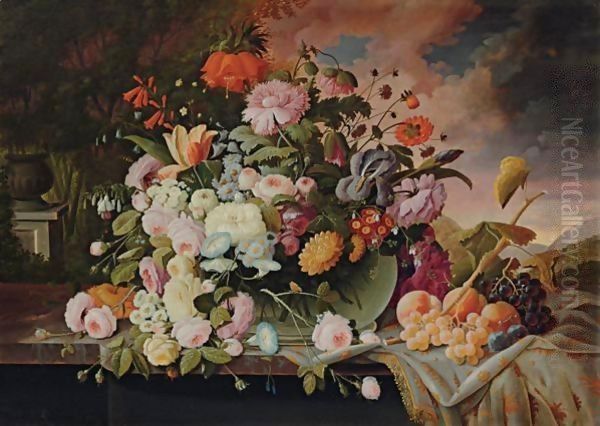
His tendency to repeat compositions, or elements within compositions, also complicates matters. He clearly developed successful formulas that he reused, sometimes with minor variations. While this speaks to his popularity and the demand for his work, it can make distinguishing between paintings from different periods difficult without clear dates. Additionally, his popularity led to imitators, and some works attributed to Roesen may be by followers or contemporary artists working in a similar style. Misattributions have occurred over the years, requiring careful connoisseurship to ascertain authenticity. Despite these challenges, dedicated research by art historians, particularly focusing on provenance and stylistic analysis, has significantly advanced our understanding of his oeuvre.
Rediscovery and Enduring Legacy
After his disappearance around 1872, Severin Roesen faded from the forefront of the American art scene. While his paintings remained cherished possessions in Williamsport and other collections, his national reputation waned as artistic tastes shifted towards Impressionism and other modern styles later in the 19th and early 20th centuries.
A significant revival of interest in Roesen's work began in the mid-20th century. Exhibitions focusing on American still life brought his paintings back into the public eye. A major catalyst for his renewed fame was the acquisition of one of his paintings by First Lady Jacqueline Kennedy during the White House restoration project in the early 1960s. This high-profile endorsement sparked widespread curiosity and appreciation for his lush, detailed style.
Since then, Roesen's paintings have become highly sought after by museums and private collectors. His works command significant prices at auction, reflecting his status as a premier American still life painter of the 19th century. Major museums across the United States, including the Metropolitan Museum of Art, the National Gallery of Art, the Museum of Fine Arts, Boston, and the Fine Arts Museums of San Francisco, hold examples of his work. His paintings are admired not only for their technical brilliance and aesthetic beauty but also as historical documents reflecting the values and aspirations of Victorian America.
Conclusion: Capturing Victorian Abundance
Severin Roesen occupies a unique and important place in American art history. As an immigrant artist, he brought with him the rich traditions of European still life painting, particularly the legacy of the Dutch Golden Age. He successfully adapted this heritage to the American context, creating works that resonated deeply with the optimism, prosperity, and burgeoning national identity of the mid-19th century. His canvases, overflowing with meticulously rendered fruits and flowers, are dazzling displays of technical skill and celebrations of natural beauty.
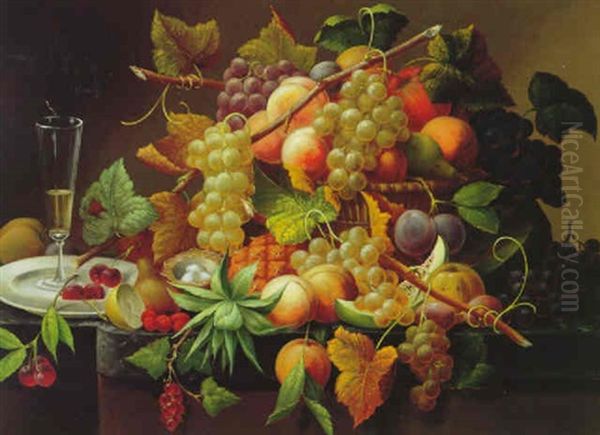
Though details of his life remain elusive, the paintings themselves speak volumes. They capture a sense of abundance and material well-being that defined the aspirations of Victorian America. Roesen's dedication to the still life genre, his mastery of detail and color, and the sheer visual pleasure his works provide ensure his enduring legacy. He remains a testament to the cross-cultural currents that have enriched American art and a beloved master of depicting nature's magnificent bounty.